Maja Voje's Blog, page 9
May 16, 2024
Before there is Ideal, there is Early (Customer Profile)
Dear GTM Strategist!
You are probably familiar with the Ideal Customer Profile (ICP)—the concept of your perfect customer, who has deep pockets and is just waiting for your product to ship.
The problem is that we don’t live in an ideal world. There is a road to your ICP; the shortest one is taking a deep dive into your early customers first.
Ever since my Go-to-Market Strategist book launched in November, the concept of Early Customer Profile (ECP) has been a hot topic on LinkedIn, in Q&A sections of online events, and many other content creators have provided their takes on the concepts. ❤️

Credits: Maruša Grah, Transformation Lighthouse and Anthony Pierri, Fletch
If you google “Early Customer Profile”, you will be disappointed. Even though ECP quickly won the hearts and minds of readers, there is little to no actionable literature on “Early Customers”. It is easy to grasp that before “ideal”, there is something else, but mental models of how to choose the right bets, actionable tools, and recent examples are missing.
Enzo Avigo, co-founder and CEO of June.so analytics solution, explained on the GTM Strategist Podcast (listen here):
“Our first users were indie developers, and it was nearly impossible to monetize them. Business finally took off when we pivoted to target established B2B SaaS companies.”
Bingo!
User ≠ Customer.
The concept of a customer includes money transactions 💰. You can get thousands of users from Product Hunt and whatnot, but that does not necessarily mean that you are closer to product-market fit, which in my book also includes building the foundations of a sustainable business model. It is called the Product-Market Fit Cycle.
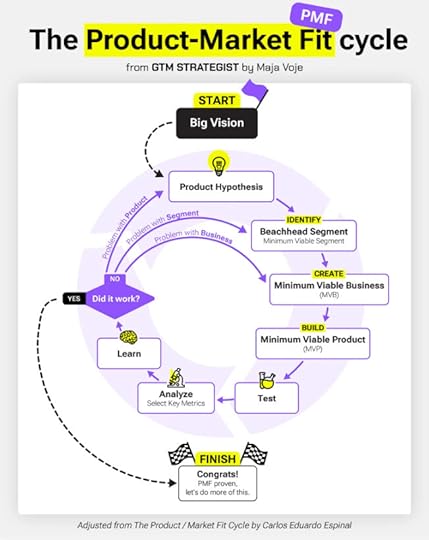
This is why today, I’ll reflect on lessons learned from more than 400 launches I have participated in. Together, we will embark on the mission to discuss examples, develop understanding, and discover some tools to help us confidently make ECP decisions.
ECP should not “just happen”. It should be a proxy of ICP.My primary reason for writing about ECP instead of ICP (Ideal Customer Profile) in the Go-To-Market Strategist book was that before you can win your “ideal customer,” you have to make peace with the fact that, more often than not, you will have to work your way up the market to get there.
Confidence comes from relevant evidence. Before your ICP has the confidence to work with you, your ECP will have the enthusiasm and courage to help you provide evidence that you can deliver value predictably and repeatedly. You need to compile a critical mass of relevant satisfied customers. This is most often done by snowballing the pilot projects to enter new markets (geographies, industries) or win higher-up decision-makers or clients with larger budgets.
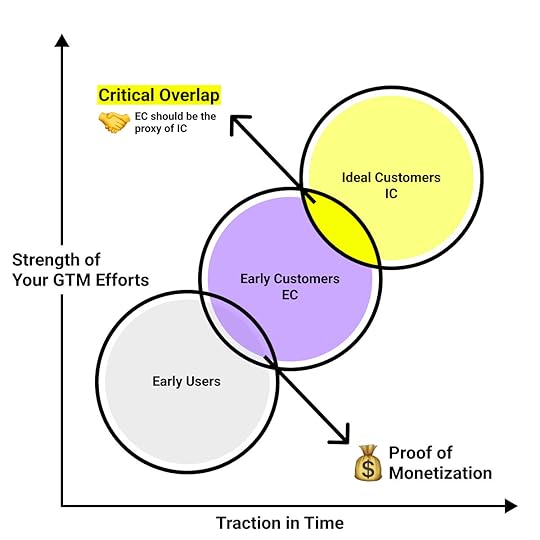
My big ideological fight with “test and learn” is that we should be proactive and intentional instead of reactive to random market insights. Sure, you can go out there, do something, and reverse-engineer a sub-segment that converts and retains well and attracts more customers like them.
But the devil is always in the details:
Are you sure you attracted the right type of audience in the first place?
Was the messaging and product experience purposefully tailored to deliver 10x for them?
Should you pivot to a different target audience (aka ICP) if the first couple of tests did not confirm your hypothesis or were invalid?
The answer is no. Target market decisions should never be taken lightly because you will have to live with them for at least a quarter ahead. The selection of target market determines all other elements of the go-to-market strategy (product, positioning, pricing, and the right growth motion). Dismissing this decision with a couple of tests or scattered poorly executed launches is a danger zone, a route to chaos.
Your true north is your objective, but your go-to-market strategy also comes from business vision and strategy and a servant of product vision. Therefore, your go-to-market strategy should remain a purposefully developed blueprint to an objective instead of a path of breadcrumbs of “market insights”. Make an informed decision and stick to it before you collect a critical mass of evidence.
You will need relevant evidence that your solution really works (case studies, testimonials, use cases, working prototypes, trust portals, building playgrounds) - a little bit like this:

It does matter a lot which ECP you choose because “alike attracts alike”. Ideally, there is an intercept of ECP and ICP so that ECP use cases are relevant and attractive to the final ICP. Your job to be done is to sell “more of the same/similar use cases” and get closer and closer to your ideal customers.
Therefore ECP does not mean that you are first “stuck” with technology enthusiasts who spend 6 hours a day in some niche communities, jump from one “shiny new thing to another,” and have a low to non-existent willingness to pay for your solution.
The question remains - How can you choose your ECP better?
5 Archetypes of ECPs: From Technology Evangelists to Agents of ChangeA common misconception regarding ECP is that first, you must win the “SMB market” before pursuing bigger businesses. I will aim to prove that ECPs come in all shapes and sizes—firmographics/demographics can be very irrelevant. The Early Customer profile is a mix of Behavioral, Jobs to be done, and Psychological characteristics.
We establish the agreement that best ECPs are a proxy of ICP. Imagine two avatars:
CMO Martina guards a 12 million marketing budget, manages 70 people, and works with 12 agencies to complete the job. Every agency delivers a different type of report, and it is hard for her to grasp the whole picture. Yet social media is not her core priority, and she will “do it when there is time.”
Kim is a LinkedIn-famous freelancer eagerly exploring AI-driven solutions to create automated reports for her clients because she hates doing them manually and wastes 8 months preparing them.

In most cases, you will likely have to win Kim (ECP) before winning Martina (ICP). Kim is already exploring the solutions and has a burning pain point and high-risk tolerance. Martina knows that she should act upon this, but it is not her core priority.
But the question remains - is winning Kim helping us get closer to Martina? Yes, if Kim is relevant to Martina.
In her micro-universe, Kim is an “opinion maker” - she posts regularly on social media, does lectures on how to win new traffic organically for leaders like Martina and Kim will eagerly share her new automated reports on social media, while if you ask this from Martina, she would have to go through compliance department in another company. Will Kim’s case be enough for Martina? Probably not, but if Martina sees that also other “social media moguls” like Marco, Natasha and Peter start using a new AI-first social media reporting tool with sentiment analysis, she or her team will repeatedly see it and start considering it.
But how “far away” should ECP be from ICP?
Are you working from “small towards big”?
Often I get asked: can I target “big corpo” directly?
Yes, you can. Often times when I work with founders, we “go big or go home straight away” so that we do not miss out on the window of opportunity nor leave the money on the table. Such an approach works well if:
Stunning new technology solution, which is not 10x, but 100x better
You are an early solution to a market with a burning paint point and can barely meet the demand.
When you have proximity and access in the segment (you actually know decision markers there and speak their language)
Pre-existing traction and evidence that make us a “go-to” solution for X. You can piggyback on your previous experience in satisfying the lucrative segment.
Let’s share some examples. This is how some teams I worked with got the first 5 BIG accounts without breaking much sweat by doing small incremental use cases:
ESG tool: The team built a demo, posted a couple of posts on social media, and got a HUGE pipeline of corporate opportunities because everyone (in Europe) is freaking out about this legislation change. The product was 10x because it was interactive.
Trusted traceability solution: Within months, the first pilots were secured through founders’ networks, events, partnerships, and co-creation with innovation centers.
HR tool for employee satisfaction: It was immediately clear that if we want to “be in green,” we need to onboard companies with a lot of employees; otherwise, we will be too slow. The team attended many HR conferences and integrated into HR communities to access those whales.
AI LLMs solution: Instead of grinding through communities, we pitched (via personalized cold outreach!) to Chief Innovation Managers of regional financial institutions - the average seal size was 30K a year.
I went back and searched for patterns in my portfolio of over 400 product launches. I did some pattern-recognition heavy lifting, and here are the 5 Archetypes of Early Adopters that I have repeatedly seen on my go-to-market journeys. I presented them as Yu-Gi-Oh cards to make it more fun for you to learn.
Let’s start with the Tech Enthusiast…
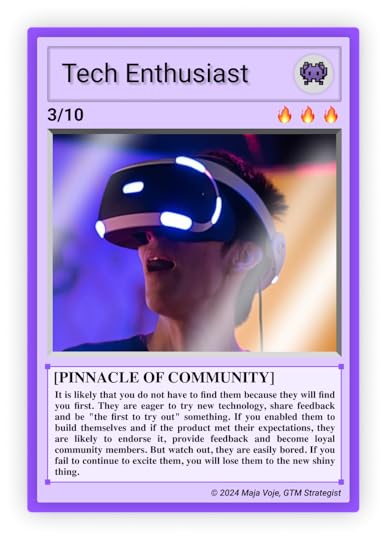
…and continue with the gentle and well-intended Underdog Supporter.

Now, what about the Game Changer?

It’s getting hot in here! Here comes the Digital Transformer.

And here’s your final boss:

Do any of those look familiar to you? 😇
OK, by now, we have a rock-solid understanding of the ECP nuances.
Early Customer Profile - ECP ArchetypeWhen we are searching for an Early Customer Profile, we gravitate toward shorter sales cycles, high pain levels, relatively high willingness to recommend, and tolerance for “imperfect” products. We usually agree on an “early adopter deal” and compromise on price a bit to create frequent and informative feedback loops for our product and gain first-paid references, social proof, and recommendations.
We said previously that the demographics and firmographics (company size, revenue, etc.) do not play a crucial role in the first iteration, but I still recommend putting a proxy of these parameters in your Archetype based on your experiences so that the ECP is more applicable (building target list, targeting for advertising, ease of communication to other stakeholders.
This is an example of an Early Customer Profile for an AI-first reporting tool for marketing teams. Here is a general template (with an example) I created. You are welcome to adjust it to your needs and liking.
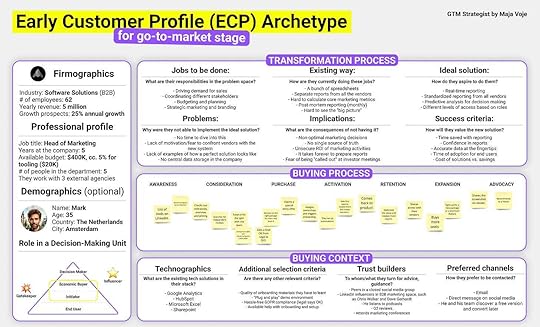
👉 Download the blank template for your use here: https://docs.google.com/presentation/d/1L5R_UtaW_areKe3cCTmEyQzp1--y8YLfdqf372WV2iY/edit?usp=sharing
ECP is best defined as learning by doing: Take your hypothesis for a spinNow that you have your ECP hypothesis ready, it is time to throw it against the wall and see what sticks. People say many things in interviews and on social media. What matters more is if you can find a group of early adopters to:
Passionately start engaging with your content
Take your solution for a spin
Experience the wow moment of it
Adopt it to their workflows
Recommend it to others in their community/network, and look cool doing it.
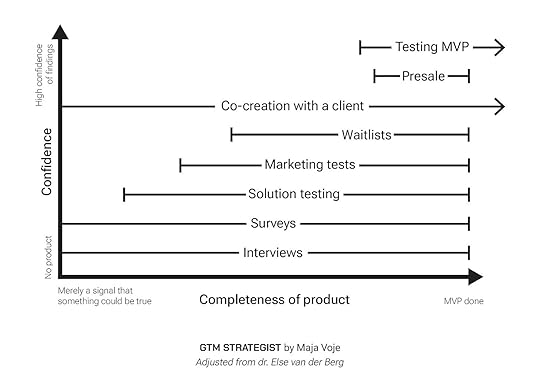
This is why we always prefer “doing” to “saying” research methods when researching early adopters. We usually use the methods to test ECP in the higher confidence spectrum. We prioritize “doing” and fast feedback loops. Here are my go-to-market networks and how I usually like to validate the ECP hypothesis:
Ask your network, VC, partner, etc., if they know anyone who is already working in the space. A warm intro works wonders. Since you are new to the market, the mates you are asking for recommendations from will automatically lean towards early adopters because their good name is at stake, too, when making this intro.
Make a contact list of potential early adopters and use outbound or account-based selling/marketing to secure a meeting with them. Avoid generic “let’s go through the menu, and I’ll show you all the features” demos. They suck and bore the s*** out of an early adopter who is passionate about solving their problem, not spending 30 min on a call with a person they do not know.
Post an invite to beta or launch announcement in a relevant social media group for ECP. Do you reach which groups are relevant to them and test the announcement/messaging with some people before you broadcast it to thousands? I dug up this example from my archive to make it a bit easier for you ❤️
Set up a waitlist with ECP indicators (do you have experience setting up, how many people are actively working on this in your team, what tools do you usually use to solve this) and calculate the ECP fit based on admissions.
Preorders and co-creation of the product with a client. In many cases, early adopters are willing to pre-buy solutions that they are excited about. What matters next is communicating constantly with them and fulfilling the promise.
Once you win their hearts and minds, early adopters are willing to wait for months (in some radical cases years) to get their hands on the solution. But only after they believe it would or will work well for them, and it is a really 100x solution to a burning pain point.
I mentored a team that developed an alert and preventive system for children who suffer from sensory hypersensitivity and could experience a seizure if they are not protected from disturbing triggers. These children have difficulties in their education and socialization process. There are reliable solutions out there. Some parents even sell their real estate to help their kids and finance research in the fields. A solution for them would be life-changing. They will wait for the right solution and closely work with companies to get there.
This is not the case if you are a “good to have” solution or something. If you work in a more cluttered space, you should know the “need for speed”. The window of opportunities is closing fast. Your savvy early adopters with a burning pain and a wandering eye for new solutions are unlikely to wait around long. Their enthusiasm will wear off. You need to act fast and decisively. Timing is everything. Engage them as soon as possible and frequently update them on your progress.
Example 1: Here is how I created a contact list and messaging for testing a group of early adopters - Chief Marketing Officers who are open to customer-engagement AI technologies to test a group with an offer. The demo is a proxy of a real case of finding Enterprise ECP that I am handling now. I used the Clay data enrichment tool to do it.
Example 2: This is a translation of the post that an indie maker posted to a couple of local social Facebook groups and got 1000 free users for this AI Bureocratic consultant solution.

I hope that you are one step closer to fully understanding and appreciating Early Customers after reading this Substack post. If you have additional questions, I am happy to discuss them in comments, reply to this email or send me a DM on LinkedIn.
Remember, when you nail the Early Customer profile, you work up the market. If you are servicing a large market, being laser-focused on your early customers can bring you beyond 1 mio ARR. The concept is also extremely useful for new launches of established companies and provides a great antidote for FOMO that could distract the focus. In the words of Highlander …

Thanks for reading, and let’s go to market!
Maja
May 10, 2024
A killer Go-to-Market slide for your company (template inside)

Clay kindly supports this Substack post. Ever since I mastered data enrichment for outbound, I screenshare it on my mentorship calls. The only way for people to understand how super-easy and useful Clay is is to see it in action in their cases ✌️.
This time, I will show you how straightforward it is to:
1. Build a list of VCs in your selected markets
2. Find decision makers and their contact data there
3. Use Claygent - an AI web scraper, to find portfolio companies of these VCs
4. How to write LinkedIn request messages to these VCs using Clay AI integration
See how I did it in 10 minutes using the FREE version of Clay
Beat me to it! :)
Dear GTM Strategist!
Does your go-to-market slide look like ChatGPT hallucinated it?
A bit of a roadmap … why not?
Naming all the channels that could possibly make sense … just in case
Focusing almost exclusively on what will happen in the future after you get the money
Name-dropping some big names of media and partnerships … not too bad 😅

P.S. This proposal, of course, did not go through me … 😃
Here is a treat for you.
I spent 3 weeks working with Jonathan Crowder thinking about the “pitch perfect” go-to-market slide. Jonathan is an experienced VC, operator and fundraising advisor who has helped founders raise $125M+.
Jonathan and I analyzed 85 successful pitch decks that resulted in $375M raised in total. He found essential patterns and reverse-engineered these best practices in a GTM Slide template that we will share in this Substack. We aimed to make this content applicable even if you are raising pre-seed, seed, or Series A and still need to secure more traction.
Even if you are not actively fundraising at the moment, this knowledge will help you work your way toward an eventual fundraising round by knowing what it will take to succeed. Most of the same principles can apply to your sales decks, partnerships decks, and other go-to-market communications (building in public on social media, press releases, event content, and company updates).
Up for it? 🤠
Let’s go!
6 Lessons based on analysis of the Winning GTM SlidesJonathan has seen over $3.75B of startup pitch decks in his career. He believes the best pitches don't have Product-Market Fit (PMF). They have 𝐏𝐈𝐅.💡 PIF = Pitch-Investor Fit
Startups sell different things to investors as they scale. Here are 6 lessons of the pitch-perfect GTM slide that will help you achieve PIF and win the minds of investors:
Lesson 1: A good GTM slide doesn't exist in a vacuum. An insightful problem/solution section queues up your GTM slide by showing the path to PMF. It makes your GTM claims more believable.
Lesson 2: Your primary GTM metrics point a VC toward what matters. You're telling them what to diligence. You need two elements: First, a leading indicator of success that can be supported with data (ex: $ pipeline at proposal stage); and second, the end results it drove.
Lesson 3: Your TAM slide should do more than state your market size. It's an opportunity to show your meticulous focus on your beachhead market and briefly articulate your long-term expansion path to capture adjacent segments.
Lesson 4: Show your weaknesses. Be sure to highlight existing weaknesses if you're positioned to do well in those areas when you give them the attention they deserve. (For example: "At a prior company, our CMO launched LinkedIn Ads channel from 0 to generate $15M ARR from our ICP at a very low CPA. Will test when we have budget.")
Lesson 5: Share clear, specific personas. Not all slide decks include buyer personas (especially for very early stage companies). But if they do, they should be very detailed.
Lesson 6: For Series A or later, you must be prepared for deep discussion about your acquisition channels: what they are, the approach to each, expected economics for each channel, and how they fit together to create a cohesive plan.
Confidence = EvidenceBefore getting into the nitty-gritty of GTM slide-making, we must embrace a fundamental truth: What is the job to be done for a go-to-market slide?
In Jonathan’s words:
“A great go-to-market slide gives investors the confidence that you know what you’re doing. It shows them that you have done your homework, that you have a realistic picture of how to acquire customers in your market, and your assumptions are reasonable. It clearly illustrates your existing traction and your go-to-market plan, and why those will result in an interesting opportunity for them to be a part of.”
In Rick and Morty's words:

Ideally, you could communicate all the financials, LTV/CAC metrics, traction per channel growth, and other fantastic metrics that smell like money. But what if this is not the case?
If you are a pre-revenue or early-stage startup, you can signal the pre-seed and seed investors that you are on the right track even sooner.
We curated some Traction KPIs that can be used to prove traction even before you get to all the cool “hockey stick financials and user growth metrics.” Which one can you use?
 The Anatomy of the Pitch-Perfect GTM Slide
The Anatomy of the Pitch-Perfect GTM Slide The slide in which you present your GTM strategy is one of the most important parts of your pitch deck.
Your GTM slide has two jobs:
Communicate that you can predictably and successfully create traction.
To present the big opportunity you can pursue by securing funding.
In your GTM slide and pitch narrative, you should focus on presenting:
What is working: a few bullet points about currently effective growth channels, key customers won, etc.
Untapped opportunities: where are the opportunities that an additional round of funding could help unlock
Here is how we visualized it:

Instead of final thoughts, feel free to reach out to Jonathan if you are preparing to raise or actively fundraising. He helps companies raising Seed and Series A rounds between $2-15M raise capital more quickly, easily and on better terms.
Till next time,
Maja
📕 Reading recommendationI usually do not make book recommendations, but when I do, they come from my favorite authors. I read Allan Dib's “1-Page Marketing Plan” a couple of years ago. It was one of the pivotal books in my career. I interviewed Allan last year for the GTM Strategist Podcast (listen here), where he announced that he was launching a new book.
Now it is finally live! “Lean Marketing” is a follow-up to the international bestselling phenomenon. It focuses more on scaling, and building processes, as the role of AI and automation is rapidly changing the marketing landscape. It can be yours for starting from $1.99 (Kindle version).
Every purchase comes with access to free training: https://leanmarketing.com/leanmarketing-bonus
May 6, 2024
FREE Go-to-Market session with 4 GTM experts
Dear GTM Strategist,
Today, I’m writing you with a special invitation. I am so excited to join a webinar with 3 other amazing GTM experts, so it will truly be a value bomb I don’t want you to miss!
GTM can be a complex endeavor. At different stages of your journey, you might be hesitant to:
select your initial customer profile,
set up pricing,
decide on the right go-to-market motion,
scale your GTM operation from securing early traction to scaling the operations.
Join us this Wednesday, May 8th, at 16:00 CET for an expert panel “Different stages of GTM: 5 myths and 5 truths”.
Emmet Gibney (CEO, Rewardful), Emilia Korczyńska (Head of Marketing, Userpilot), Samantha Ali (Growth Marketer, Usersnap), and I will share hot GTM takes on:
Research + Planning
Product Development
Marketing + Positioning
Sales + Distribution
Feedback + Optimization
There will be an opportunity to ask questions, so don’t hesitate to throw your challenges at us.
Register (it’s free) and take your go-to-market strategy to the next level with us ✌️

Hope to see you there!
Maja
P.S.: My friends at Usersnap who organized this webinar are also doing research on AI's impact on product management. They will value your response to a short survey. Their primary objective is to gain deep insights into how digital product managers and organizations are adapting to the integration of AI technologies and how this adaptation is shaping their approaches to research, development, and customer retention.
Discover if AI is your friend, foe, or both. 🤷♀️
May 3, 2024
In search for your Ideal Customer Profile (ICP)
Dear GTM Strategist!
Last week, I worked with a group of B2B SaaS entrepreneurs in Graz, Austria. The question that most founders who are starting out asked at Q&A and networking was:
“Whom to target first when we go to market?”
It was such a right question to ask.
Selecting the right target market is one of the most important decisions you must make on your go-to-market journey. Everything (pricing, product, positioning, channel, etc.) evolves around your choice of target audience.
Something else happened.
After my previous Substack, which was focused on Outbound, many entrepreneurs replied to me privately on LinkedIn and email:
“I know we should be doing outbound, but starting out is really hard. I am stuck.”
I was surprised to hear that. If you have existing traction, you can reverse-engineer your most successful segment and use outbound marketing to attract more similar companies.
Today I will provide you with frameworks and hands-on guidance on how to:
Make target market decisions with confidence (confidence = empirical proof)
What makes a phenomenal “beachhead segment” (segment ranking sheet)
How do you build a contact list for interviews or prospecting for outreach
Let’s clear some nomenclature first:
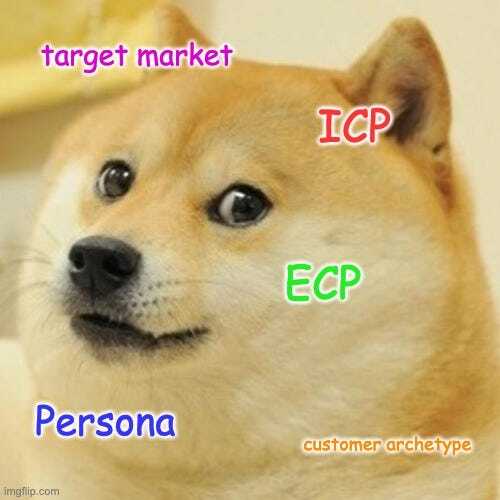
Target market = a broader term used when we simply agree that niching down is the key to our differentiated go-to-market strategy and when we finally drop the idea that “the product could help everybody”. It can eventually, but first, we must create some traction and make some money.
Beachhead segment = a section of the target market that you have purposefully selected to conquer first - a narrow segment with a high pain point, the urgency to react now (not in 6 months when they will have the budget), willingness to pay, and healthy growth potential that you can access easily.
EPC = Early Customer Profile - early adopters of your solution
ICP = Ideal Customer Profile - your actual target market, the early majority that will take you across the chasm and move you from the go-to-market stage to the growth stage
Persona/Customer archetype = a visual representation of your selected target market that makes its attributes easier to communicate and more actionable for other players in your go-to-market team and beyond.
Theory over. Let’s get into tranches of selecting and validating ICP for real.
Scenario A: You have little to no previous traction, and you want to maximize your chances of winningI am a huge believer in the Beachhead strategy.
What does it mean? Instead of scattering your efforts among the vast marketplace, you will get much further if you first focus your resources on a narrow target segment you can win in the next 3-18 months. Even tech giants such as Uber, Figma, Google, Amazon, and Facebook used beachhead strategy to gain early traction.
In this carousel, I briefly explain everything you need to know about beachhead strategy. Take a look here.

TL;DR:
An ideal Beachhead segment checks the following criteria
A burning pain point
High willingness to pay
Healthy growth potential
You can access it fairly easily (proximity)
Is a sub-segment of a larger market that you can expand to
For finding your best target segment to start, here are two tools that will help you:
Segment ranking table will help you narrow down from 10+ to 3-5 hypotheses
With our beloved ❤️ Market-Problem Map (it won Best Strategy Framework award by Miroverse), you will find the best candidate to test first among 3-5 candidates
You can test different segments using one or more of the following validation methods (I added tools to the list to make it more actionable)

Remember, if people say they love it, it does not mean they will pay for it.
Interviews are useful for gaining deep user insights throughout your go-to-market journey. But if you want to be more confident in validating the early business model (willingness to pay) in addition to product-market fit, choose methods where prospects are actually showing purchasing intentions.
Do > Tell.
If you have questions or want to dive deep into validating your target market and winning early traction, join me on May 8th at 16:00 CET for an expert panel Different stages of GTM: 5 myths and 5 truths. Emmet, Emilia, Samantha, and I will share hot go-to-market takes on:
Research + Planning
Product Development
Marketing + Positioning
Sales + Distribution
Feedback + Optimization
Register for free here and take your go-to-market strategy to the next level with us: https://us02web.zoom.us/webinar/register/4417137938113/WN_2wr4bKWPQdKGyIQmYzKgCQ#/registration
 Scenario B: You have previous traction, and you can reverse-engineer your most successful users
Scenario B: You have previous traction, and you can reverse-engineer your most successful users Many product leaders might come chasing me for saying this, but I will do it anyway. As a leader of bootstrapped companies that optimize for revenue and profit as early as possible (not thousands of free users before figuring out our business model), I would reverse engineer based on LTV (lifetime value) instead of activation, retention, and whatnot. I must build a sustainable business model and win early traction to take the company forward. Here’s the template of the scoring table I use: https://docs.google.com/spreadsheets/d/1nasUvb4tZV71NcKS_Ap6fGw3rqt0Ls79IjJKL9mf3a0/edit#gid=0

What does that look like in practice?
Simple.
List down all the clients.
Rank them based on annual recurring revenue.
Add some other factors to the prioritization mix, such as growth potential, joy level when working with them, business ROI, etc.
Ask yourself how to attract more customers that resemble the firmographic profile of your most valuable consumers.
Build a target list of companies.
Let’s go 🚀- reach out to them, publish a new advertising campaign or go where their attention already is (communities, events, relevant influencers, ….)
If you are not monetizing yet or following the strategy of optimizing for adoption, you can do the ranking differently, but the same logic applies.
Let me show you what this looks like in practice.
If I wanted to find more supporters for this Substack, I would do a profile of a “target supporter” based on the characteristics of those who currently make the highest supporter pledge. I could also add companies that are already supporting similar Substacks in the space and reach out to them since they are used to working with content creators and apparently have the budgets for it.
Cool, cool, cool …
Demo time 🥁🥁🥁
Here is how I build a list of such companies using the Clay data enrichment platform in less than 5 minutes. You can do this using their FREE trial. No more excuses, you got this! ✌️
That was not too difficult, was it? Take it for a spin yourself.
Find more opportunities similar to your most successful clients in a couple of minutes.
And … That is all, dear folks!
Your turn: follow the guidance provided in a scenario that best suits your go-to-market terrain.
Remember, doing and validating is better than guessing and being trapped in analysis paralysis.
Confidence comes from your ability to find the right answers and solutions for your situations repeatedly.
Let’s put in the reps, and one day, you, too, will share the wonderful story of how you successfully pivoted from early customers to ideal customers using a beachhead strategy.
Let’s go to market!
Maja

If you need more guidance and examples to get started, Chapters 2 (Market) and 3 (Early Customer Profile) of my best-selling Go-to-Market Strategist book unveil more answers. Go to https://gtmstrategist.com/ and get a free preview of Chapter 2 to get a feel for how the book looks. This book is not “read it and be done with it.” It is a guide to the Product-Market fit that has helped thousands of companies make go-to-market decisions with confidence.
April 26, 2024
Outbound is too important to ignore (+ starter pack inside)

Clay kindly supports this Substack:
Clay helps go-to-market teams uplevel their data enrichment and outreach workflows. It consolidates 75+ data enrichment tools into one credit-based marketplace, letting you search multiple tools at once for contact info, company details, and more. They’ve tripled data coverage and quality using one or a few tools like Zoominfo—at a tiny fraction of the cost.
Get 14-day Free Trial of Pro Pack
Dear GTM Strategist!
Last week, I visited Bosnia and Herzegovina with the Swiss Entrepreneurship Fund. I met over twenty teams in three days, each showcasing its exceptional talent.
These teams craft top-notch tech solutions for clients in Scandinavia, MENA, the USA, and the DACH region. The potential for outsourcing full-stack development from this region is immense, with companies making up to $50 million in annual revenue and project deal sizes up to $2 million. Many teams are also developing their own products.

As we sat down with founders to discuss their go-to-market challenges, one thing became clear:
Almost all business deals flow through recommendations and partnerships.
I was shocked to realize that almost NONE of the companies had a structured, systematic outbound sales process in place, which can be one of the best-performing channels for such companies.
While it is common for a service company to get 60-70% of businesses via recommendations, the times are getting tougher.
Waiting for recommendations in our comfortable offices no longer cuts the chase. Companies should be more proactive in attracting and engaging potential clients.
If your organization does not do outbound - consider doing it now.
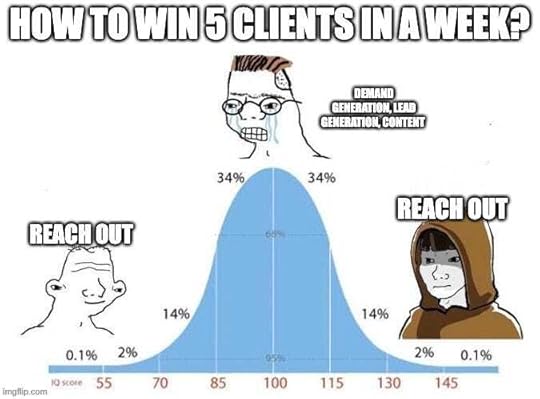
Many B2B-oriented businesses still view outbound with skepticism, seeing it as a pushy, complex, and unreliable process. But if done right, outbound as a growth motion can be highly predictable, forecastable, and a high ROI revenue channel, transforming it into a strategic asset rather than a necessary evil.
And it made me wonder …
Why does outbound have such a bad reputation?Why do founders want to avoid it at all costs?
Well, as it turns out, we often don't have to look further than our LinkedIn inbox… Does this look familiar?

I am bombarded with poorly thought-out outreach attempts. Therefore, I rarely visit the invite section of my profile. Yet, if someone writes me a relevant, thoughtful comment or suggests a mutually beneficial opportunity - I often will respond almost immediately. Personalization and relevancy can make a radical difference.
There is a better way: How to do outbound like a boss 💪I'm raving about outbound in 2024 because I have seen it work incredibly well if done thoughtfully. In the last year, I have worked on several projects together with my B2B Outbound sales partner, Jaka Berdnik. His outbound campaigns generated millions of € in client pipelines. Here is a case study from a recent consulting project:

If you think this sounds great but have no idea where to start, here is some good news: you can start doing outreach manually without any complex tools. Create a list of 200 companies, personalize the message (better yet, get a warm intro), send those emails or LinkedIn messages, book the meetings, and close new sales opportunities. You can move to more sophisticated tools after you gain more confidence in outbound.

Of course, there are more tools that we could include, but we believe these are the best for companies in the go-to-market stage.
What would you add? Let us know in the comments!
I am always on the lookout for new tools and opportunities.
Start your outbound engine: Structure of a successful outbound campaign.Instead of evangelizing that outreach does not work because you are bombarded with “Dear Sir” emails, give it a shot. However - make sure to do your own research first. Keep in mind that:
Outbound sales and marketing aren't for everyone. They don't produce outstanding results for every type of business.
Conversion rates can vary highly based on your target industry or location.
Whether it is financially viable for your business can vary based on your average deal size.
Jaka provided us with a few comments on what not to do on this Cold Email Copywriting Roast:

Ready to do it much better?
Start learning about the structure of good B2B cold emails here: https://www.clay.com/blog/b2b-cold-email-templates?via=299452
Check out cold email copywriting tips to help you get started ✌️https://www.clay.com/blog/b2b-cold-email-copywriting?via=299452
Need more? Check out the cold email repository at Lemlist, too - it is great. They have a lot of community contributions and share benchmarks https://www.lemlist.com/cold-email-templates
Do you want to use templates and campaign automation? Here are more ideas: https://www.clay.com/templates?via=299452
Outbound offers an opportunity to significantly grow your business by generating millions in a predictable sales pipeline.
If you are second-guessing whether or how you could unlock this powerful go-to-market motion, reply to this email and tell me a bit more about your business and target market. I will give you honest feedback and let you know if it is worth pursuing. No strings attached. I would like to see more businesses utilizing this powerful channel to have cool case studies on this Substack 😇.
Up for it?
Let’s go to market ✌️
One email at a time!
Maja
Want more?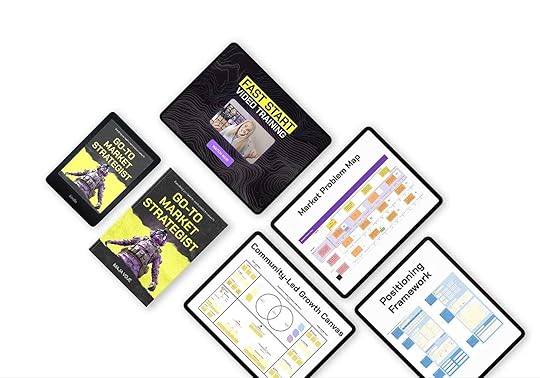
Jaka and I co-authored an entire chapter dedicated to outbound sales and Account-Based Sales in the GTM Strategist Book. If you already have the book, hop on page 275 for more insights, or go to https://gtmstrategist.com and get it this weekend. ✌️
April 19, 2024
How to win the LinkedIn game fair and square?
Dear GTM Strategist!
LinkedIn is not just a platform. It's a gateway to success in the B2B arena and a key to securing your next investment. It's where your customers, partners, potential investors, and other stakeholders will inevitably look you up.
However, LinkedIn can also be a very cringe place:
“I used to be so afraid of public performance. Now I hit the stage 3x a week.”
“I started my company with $20. Now I have 200 people working for me.”
“Yes, Stacy. Content marketing is very important. Keep on slaying on social media.”

With all the drama, your above-average IQ may resist all the shenanigans and keep you away from the platform.
Beat the instinct. There are indisputable benefits of having a presentable LinkedIn profile and being active on the platform at least 1-3 times a week. I give this advice to all the founders in my network, and I am happy that some follow it to the T.
Congrats, Dragan, on overcoming the urge to hide from recruiters on LinkedIn and starting to build in public. I am so very proud of you and Gorjan. You are one of my favorite examples of how technical founders can thrive by building in public. A year, a couple of pilots, and an investment round later, you made me so proud!
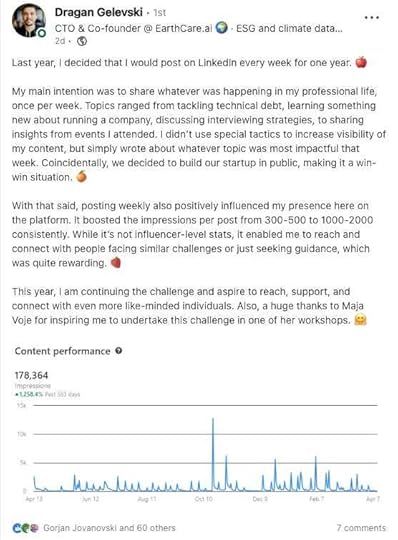
You can play the game based on your rules. LinkedIn is too good to miss out on.
I spent the entire weekend analyzing 199 posts from 25 brilliant content creators on LinkedIn to get hands-on insights into playing the LinkedIn game like a PRO.
Let’s bring it on!
The method: No hook meisters in the sampleOnce a quarter, I do a LinkedIn content moodboard by analyzing the creators in similar spaces (go-to-market, product management, B2B marketing, and product-led growth) to get new ideas for the content and visuals. I usually share it with my team and mentees, but this time, I was like - why not make it semi-public?
Here is how I did it:
Since January, I have been saving posts that catch my attention on LinkedIn. Overall, I have saved more than 400 attention-worthy posts that add value.
Not everything that seems attention-worthy to me ends up being the best-performing post, so I reviewed the traction on all these posts and limited the analysis to content creators with a method and signature style so we can learn some patterns.
I analyzed 3 months of their post (mid-JAN to mid-APR) to find patterns - what topics and formats performed extremely well for them. It felt a bit like solving a murder 🤠
Then I studied the categories and derived advice and interesting best practices that you and I can use to inform our content creation process.
 The results: Value-first is still the name of the game in our space
The results: Value-first is still the name of the game in our spaceMany of my colleagues in the space complain that the LinkedIn algorithm has become totally random and that it is hard to counter the “fortune cookie” wisdom noise with intelligent content. Luckily for smart life, I have collected the opposite evidence. Over 75% of the best-performing content in my sample are knowledge bombs: models, infographics, cases, and processes. While nearly everyone is “guilty” of an occasional meme or emotional post, the lion's share of best-performing posts adds extreme value to the audience. It is like a virtual textbook, and it is the most candid conversation about business traction that you can have with a fellow human.
Best-in-class creators have a signature style and often reshare best-performing topics and posts to double down on the reach. Apparently, the audience loves numbers and quick tips on how they can benefit from the content, aka “cooking recipes for business growth”. There was also a lot of “common sense” against the buzz ideas out there and contrarian views. Many creators openly (not pathetically) share their struggles. That makes them human.
Without any further ado, here is the LinkedIn Best-Performing Content Moodboard, made with love over the weekend. It is designed to help you quickly grasp patterns and get content ideas for your Big Swing on LinkedIn.

Some takeaways 🥡:
Most content creators post a few times a week.
Product launch posts work well when they show a product and tell the story behind it.
“Building in public” is best accompanied by screenshots, applicable tips, and social proof (testimonials).
Memes often have good reach, but they should still stay on your professional topic and nail the pain point.
Longer text-only posts can be extremely impactful but need a good hook.
Videos are usually 1-3 minutes long.
Familiar logos attract attention.
You can find many examples of how to structure knowledge posts and infographics.
Image+text is by far the most common format
Applications to the content strategy: Experiment with formats moreWhat was obvious from this analysis is that best-in-class content creators swear by knowledge sharing, but they also include other formats and themes in their content strategy. That can be a personal story, video, meme, carousel, or short snippet.
My next steps after conducting this analysis are:
Send the board to the design department for additional patterns.
Try out memes - I am considering a partnership with a cool 145K+ LinkedIn Page called Lazy Programmer. The founder read the GTM Strategist book and is a really cool guy. ✌️
I will drop “topic weeks” in my content planning since I need faster iteration loops.
I will hire a freelancer to help me tackle the infographics and teach me how to get great at their briefings. I thought: “We have 350 pages of book insights to repurpose and upgrade. How difficult can that be?” It turns out that very 😅- it is a science of its own.
Regarding frequency, I have a huge FOMO that I should be posting daily because, over the launch campaign, we posted 2x a day. It is not rational. It is just something that weirdly sticks with me like a guilt trip. I will mediate or whatnot to embrace the reality that many top content creators post 2-3 a week or even irregularly. You cannot outwork the system. But you can outsmart it with deliberate content strategy and faster feedback loops (I hope).
While LinkedIn algo remains a weird beast, the intelligent life still hangs out on LinkedIn. For most readers and Substack, optimizing for the number of leads and meetings is better than for reach per se, but it does feel great to have a “semi-viral” post here and there. It attracts new people to your ecosystem. While content creation is a long and resource-intense game, the least you can do is apply these principles to your LinkedIn profile. If you invest in outreach or ABS (Account-based sales), Let’s wear our Sunday suit on LinkedIn.
This is why I created …
🎁 Special Bonus: Since I had so many content creators in one place, I went ahead and created another moodboard - screenshots of their profiles to get additional ideas on how to pimp up our LinkedIn profiles and optimize them for conversion.
Here, dear:
I hope you enjoyed our LinkedIn conversation and found the assets useful.
Start by copying the style of great performing posts by others.
Eventually, you will find your signature style.
Play with numbers - it’s fun!
Search for patterns.
Reverse engineer.
Again and again
and again
🌲 😂

If you have any questions or dilemmas about how to apply this research, hit me up.
Really. Usually, less than 2% of people who receive the content reach out.
Reaching out makes you special, and you bet I will remember you.
Have a great day & create at least one post this week on LinkedIn.
Not for me, but for you ❤️
(you might like it).
Let’s go to market! 🚀
One LinkedIn post at a time ✌️
GTM Strategist 2.0: Start your Go-to-Market Engine!
If your go-to-market journey still feels like an uphill battle, I can definitely help. Let’s face it, most founders and GTM experts are smart enough to comprehend what they should be doing intellectually. The real challenge is prioritizing and selecting the best sequence of steps to get the ball rolling. Hop to https://gtmstrategist.com/ and get a proven set of steps that have helped more than 4700 practitioners nail their go-to-market strategy.
Do you have a colleague who would benefit from the go-to-market system? Sharing is caring ❤️
Thank you for helping me spread the word so I can spend more time doing cool research to share with you for FREE on Substack & LinkedIn!
April 12, 2024
AI is changing the rules of the game in Go-to-Market
Dear GTM Strategist!
It breaks my heart when I see smart people doing unwise things.
One of the biggest self-sabotages I see when working with go-to-market teams is over-engineering or procrastinating the launch.
The window of opportunity is not open indefinitely and the barriers to entry have never been lower. With the widespread availability of AI tools, it's irrational to ignore the fact that AI has fundamentally altered the rules of the game.
You know how much I love it when you share your go-to-market success stories with me 🙌. Seeing how you applied lessons and frameworks from the Go-to-Market Strategist book fills me with joy and motivation.
Today, I have a special eye-opening treat to share with you.
The maker (he wants to stay anonymous for now, so let’s call him Galileus or Gal 😃) spent seven months working part-time on a native AI to answer legal questions based on local legislation. He is a data scientist and a developer, and guess what—he does not like marketing.
Take a quick look at this chart:

What makes it special is that the user acquisition was done with 5 posts to Facebook groups + 1 Reddit post.
It took the founder approximately 6 hours (not days!) to prepare and nurture this launch. From this “buzz,” he got:
5 invitations to media interviews,
4 extremely luring partnership opportunities,
3 great ideas for a business model based on inbound requests.
What is more interesting is that the product has managed to retain some users and trigger referrals. Yesterday, when we had a consultation, I asked the founder: Did you do anything post-launch—an email, social media post, or any in-product messaging?
He said not (yet).
And that, my friends, is a brilliant signal that he is on to something BIG here.
Early signals of product-market fit are lightning.
Let’s dive deeper.
Is simple the new beautiful?Sometimes good products do not need (much) marketing. Gal is not the only case of bootstrapped founders who have built AI-first solutions and launched super-light products that people love. The speed of execution and feedback loops from the market are the best antidotes for product-market-fit inertia.
In the ever-lasting race of David against Goliath, each has to play on their own strengths. But the quicker and leaner they can both be on this journey, the more likely they are to hit the jackpot. While the enterprise fortresses are nearly bulletproof for indie tech, AI is changing the game dramatically in low- and mid-value markets. There is no universal recipe for winning the Hunger Games of Go-to-Market, but this image can give you an idea that 0-10 customers can be won in a super-scrappy manner if you are playing on your strengths.
 I want it all! I want it all now!
I want it all! I want it all now! When we read such stories, we get hyped. Maybe even impatient. Before you say “go, go”, let’s agree on some fundamental principles:
Go where the audience is. Simply ask them where they actively search for solution in the problem space that you are solving.
How you will get the first 10 customers differs from the first 1000 customers. You probably already know or can easily access your first adopters. To grow further, you will need more scalable go-to-market motions.
Great things take time and reps. Rome was not built in a day. When you start as a new player, you must establish trust, traction, and goodwill. Let’s face it: first attempts will probably not be the best attempt. You get better by doing it again and again.
So before you “go, go”—go and check what is likely to be the best fit for your audience and how long it will take to give that Go-to-Market motion a fair chance. Sometimes, scrappy is just too scrappy. Claiming that “advertising does not work” after you spent $500 in a week or that “InMail is a scam” after messaging 100 companies once makes you look ridiculous. Be smart(er) and more patient.
 Adiós Monkey work! 🙈 Hello AI!
Adiós Monkey work! 🙈 Hello AI! However, as a founder or busy professional, you do not have all day to consider your next LinkedIn post. You have other worries and obligations in business. The thought that you need to create a critical mass of texts, images, and videos and follow up on all these sales calls drains you and makes you nervous.
Work smarter, not harder. AI tools can elevate your productivity and quality of work. Save your brain power for strategic work that actually makes a difference, not manually transcribing your meeting notes from a notebook to CRM.
Here is a list of AI tools that can make your life in a certain AI motion a bit easier and more manageable. Let me know if you’d like to add any tool that is helpful to you!
 Your turn! Get the ball rolling.
Your turn! Get the ball rolling. If you feel trapped and stuck with stagnating traction or worse - if you are self-sabotaging and procrastinating launch because it is not “good enough yet”. Stop. Take action. Consider trying a new GTM Motion, find a subsegment of users that love your product, try to get more of them, and most importantly, do not feel sorry for yourself. Seek solutions and good advice from people who have done what you want to do (exclusively, you do not need more fluff in your life), and put in the willpower and work to get the ball rolling. Remember, if it was easy, everyone could do it. You are working on something which is hard to do. And this is how legends are born. So go - strike!

I have a little something to help you started:
🎁 Special Bonus #1: Don’t know where your audience is actively searching for information in the problem space that you are solving? Just ask them. Here is an example of how we did this research by directly asking our ICP member what is relevant to them.

🎁 Special bonus #2: Do you wonder what the magic messaging is to get 1000 users from local FB groups? Of course, I will share. It is much more simple than you imagine.
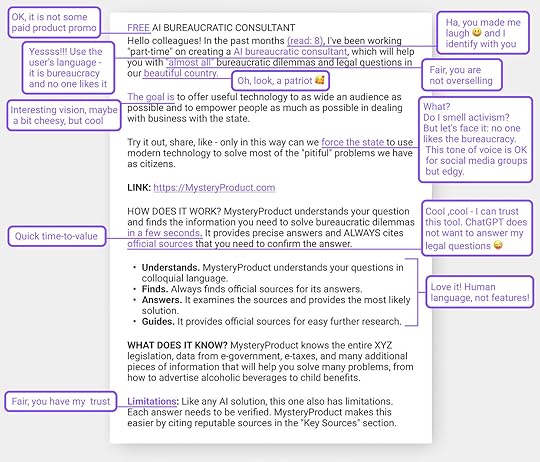
Thanks for reading this post!
It was a bit more “all around the place” than my regular Substacks, but every conversation I had with my mentees this week ended up with either productivity talks, prioritization, time management, or mental robustness. Therefore, I felt it was important to address these topics and GTM tactics, which we all love.
But before I turn to some “fortune cookie wisdom” whisperer, I’ll say arrivederci and wish you great success and prosperity on your go-to-market voyage!
Let’s go to market!
Maja

PS: If you need some extra guidance in selecting the right growth motion and turning your GTM operation into a revenue-making machine, I have prepared a 50-minute training course that you can get at https://gtmstrategist.com/. If you have already studied the book, I’d be grateful if you recommended it to another person who could benefit from it. Allegedly good products need no marketing 🤠, but it can help more people cross the chasm faster if we join forces on this journey.
PPS: Did you read the book and have an interesting go-to-market story to share? If so, hit me up. I am eager to learn it, and maybe you will be the star of this Substack next time. ✌️
April 5, 2024
5 Mistakes I Did with my GTM Strategist Launch
Dear GTM Strategist,
We are celebrating 5 months since my best-selling book Go-to-Market Strategist was published on Amazon 🎉. As happy and grateful as I am that more than 4500 readers read the book, I keep on getting positive feedback on how you applied the knowledge daily 🙏, I made some post-launch mistakes that cost me dearly …

In this Substack, I plan to share my retrospective of the launch with you and my plans on how we can do better in the future. This week I am launching GTM Strategist 2.0 🤩 that will help you apply the learnings from the book to your businesses faster and better. If you are only interested in that, jump to https://gtmstrategist.com/ and unlock their power.
But if you don’t mind me whining a bit about the launch, here are 5 mistakes that I made with it. We will dive into each of them, and I will share my plans for how we will do better in Q2.
Here are my top 5 launch sins:
Overreliance on the external platform
Optimizing for the wrong metric
Saying yes too often
Mistaking ECP for ICP
Iterating on the launch too late
Let’s dive into each one!
Overreliance on the external platform
Would I like to have thousands of books I pre-paid for in my garage and visit the local post office daily? Hell no. Amazon print-on-demand was a life-saver in terms of the logistical hurdles of shipping the physical book. Since many community members are keen Kindle users, launching on Amazon was almost a no-brainer. Becoming the best seller in the first week after launch helped us to gain a better reputation and boost sales via top charts.
But then the honeymoon was over. We still have steady ongoing sales, mainly driven by my organic LinkedIn posts (that take me 8 hours a week to write and nurture 🙈). I can do that, but to have a decent value ladder in my business, it would be foolish to rely on the fact that 5-10% of Amazon buyers add me on LinkedIn, and then they can get ever more content there.
I never went to the business to sell a $27 piece of paper. I consider my book to be an extended business card and a tool to help others succeed at scale. I could survive the provisions and delays in the payment schedule. Still, I cannot overcome the fact that I have practically zero customer data from Amazon and close to zero opportunity to learn from their feedback.

Solution:
My biggest investment in Q1 is a bundle of the GTM Strategist digital products.
This will help me get better feedback loops and develop higher-value-added tools to help you advance your go-to-market strategic efforts.
I am really excited about this launch. My team has worked tirelessly on it for two and a half months. Show us support by visiting https://gtmstrategist.com/ and exploring the options. ✌️
Optimizing for the wrong metric
It is embarrassing to admit that I got a bit “too obsessed” with the book sales numbers. For a year, I believed that it was “mission critical to sell 2000 copies” of the book, and the rest would align.
The “rest” became more important than the number of copies sold post-launch, but I had difficulty transitioning to the new One Metric That Matters. One could say mission-critical.
After the book launch, I got a lot of invitations:
For consulting and mentorships
For events and teaching
Networking calls and partnership opportunities
I think I have prioritized them in a non-optimal manner. In the Go-to-Market Strategist book, we say you can optimize for adoption or profit. I wanted to optimize for adoption, but it was a rigged game. Pushing Amazon sales of the book was definitely not the right business decision. In retrospect, I should have spent way more time polishing my offers, being quicker to reply and test the willingness to pay, and qualifying the partnership strength potential for “networking calls” much more diligently.
Solution:
I do not care a lot about book sales anymore. We reduced the number of posts to 3-5 a week (during the launch, we were pumping 2 posts a day). I also limited my number for “customer discovery and networking calls to up to 7 a week. I have not done this because I would be some greedy bastard but because it is really hard for me to say NO as a recovering people pleaser.
And that leads us to the next one …
Saying yes too often
Post-launch, I spent countless hours on non-sense calls. While it was great to learn from the readers, my learning curve got flat, and I was “polite enough” to still do it. Sincerely, I have FOMO - what about if there is a great opportunity- oh, I really want to help people. I can, but one-on-one calls are an extremely draining and non-sustainable way to do this.
I had to set up some boundaries.
A friend gave me a great advice:
“If it is not a hell yes, it is a hell no. Your default answer should be no.”
Easier said than done, friend.
I was raised to say hi to strangers on the street.
I grew up thinking that there is a gem under each stone.
There really is not.
“People pleasing” only leads to exhaustion and losing one's sense of self on the journey.
It is a form of serotonin addiction that sits somewhere in between the victim and the rescuer in the Drama triangle, which is a very useful concept for analyzing some toxicity in one's life.
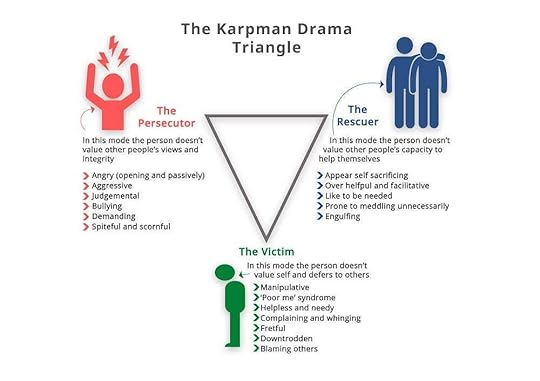
Solution:
It still burns when I have to say no, but I grew to understand that people-pleasing leads to ultimate exhaustion and that I am operating with limited time and energy. To make the best out of it, the solution is not to book out two days a week for “discovery and networking”. A much better way is to build scalable ways to interact and share knowledge.
Mistaking ECP for ICP
Usually, early adopters (ECP) are not what will turn out to be your best customer (ICP). When you start out, the support of early adopters is incredibly important, and be forever grateful to them. But it is unlikely that you can build a sustainable business based on people who are always looking for the latest and greatest and normally have low to non-existent willingness to pay. Treat them kindly, but to build a sustainable business, you will need to reach the audience with a much more predictable willingness to pay and do well with them.
Early adopters were extremely important in my book-writing journey. They were generous with feedback and supportive to the journey, but tell you what - many did not even bother to buy the book 🙈 Of course - I gladly send it to them for free as a token of appreciation for their support - but how on earth could anyone build a sustainable business that way?
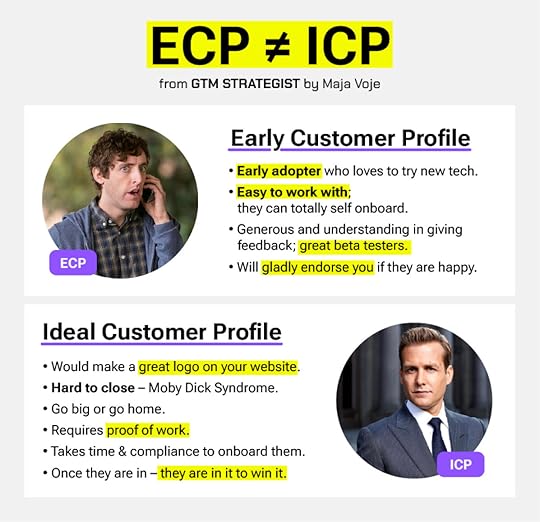
Solution:
While my ECP was definitely product managers, go-to-market experts, and technical founders who can get amazing value added from the book, and many of them have DIY the implementation of concepts to have epic launches, the TRUE ICP on the journey that followed are innovation managers, founders of companies that make at least and heads of marketing/growth who would like to get closer with their product teams and align on go-to-market approach on a company basis. I also have many requests to launch a “train the trainer” program, mentorship programs for B2B marketing, and “service scaling programs” for service companies who would like to go product-led. Still, I have to be mono-focused because we have not done everything we can in the go-to-market realm.
And last but not least …
Iterating on the launch too late
In all sincerity, I wish that I had taken a month off after the book launch. At the same time, I think that it would be stupid to do it right after because the momentum was amazing, and it would be a mistake not to seize it. But I could sincerely do it in January or early February. I have not gotten to this sooner because it is really hard to switch from 100 to 0 or one. It is not a switch. It is a process of calming the nerves down and acknowledging that we are back to normal but 4.0 - an elevated version of “business as usual”. It was also difficult to admit - ego screaming” that some assumptions were just not right. In retrospect, I wish I would have taken time to reflect on everything much sooner. But I did not.
Now we have to move to the next level!
So, today, I’m announcing GTM Strategist 2.0. The enhanced digital version of the book is now available directly on its website, together with a fast-start video training and fill-out templates that will help you craft your perfect go-to-market strategy.
My work doesn’t stop here. I’m already working on even more products that will be added to the ecosystem, like a GTM checklist and an online community.

My plan is to move our business and collaboration to:
GTM Strategist domain
Kick off the closed Slack community
I provide you further guidance with new products that I have developed in Q1 by working with the team and
Lastly, I would like to spend more time with you in a community and office hours form.
Let’s continue to learn and grow together.
Bon voyage once again https://gtmstrategist.com/ - I know you travel well ❤️
Thank you so much for your support, and definitely let me know if you have any questions or further insights on how to build our GTM Strategist Universe.
Love,
Maja
March 28, 2024
What gets measured gets done 📈
Dear GTM Strategist,
If you have a perfect overview of your business KPIs, I am so happy for you but also a bit jealous.
Ever since the book launch, our team has been stitching together data from Amazon, Substack, LinkedIn, and the website. I calculated that in total, we “wasted” more than 45 hours (a full-time work week of a person) in the last five months stitching data together every week to build a basic overview of the business.
What is worse, I do not have any attribution data from Amazon and have very limited capacity to contact customers.
Enough is enough.
We will soon launch a self-hosted digital product (my biggest investment in Q1), and I will not make the same mistake again, especially because we will also invest in ads. There will be no more “guessing” where the purchases come from.
I am putting together a mockup of my “perfect dashboard” and reading this report by Amplitude to avoid more data fiascos.

Amplitude, a digital analytics platform, also kindly supports this post. Beside that, they have also participated in many great examples for my book GTM Strategist 🙏. I am currently studying their report, 10 Mistakes You’re Making with Your Digital Analytics, as I prepare an analytical system for the soon-to-be-launched GTM Strategist digital product. You can get the report here. Kudos to Amplitude for supporting independent communities such as ours. Show them some love! ❤️
Now, let’s tackle my challenges.
When OMTM is a better choice than NSMMany people will say that you start setting up your analytics system by finishing the North Star Metric (NSM) workshop.
Most growth consultants would go on autopilot here. Expect a monologue:
“For Uber, the North Star Metric is the number of rides; for Spotify, the time of content consumption (hours of music played); for Amazon, it is the number of purchases per Prime Subscriber. What is yours? Think hard about how to describe the value that your product is creating. And it cannot be revenue or profit - think value first!”
I would disagree and I never do NSM workshops with pre-PMF teams.
Let me explain why.
Short answer:
While you are searching for your product-market fit, audience and products change (or die) rapidly. How can you set up a “guiding metric” for years to come on something so volatile?

Do not get me wrong, NSM is wonderfully aspirational. My NSM is the number of businesses that crossed the chasm using the GTM Strategist framework (the goal for this year is 10,000), but it takes me forever to get a feedback loop, so I would not center my content system around it.
Long answer:
Meet Jakub. He is our community member from Poland 🇵🇱 and the founder of naffy, a platform that empowers influencers to monetize their audience with digital products.
Q1 was great for his team. His main challenge in Q2 will be … Monetization.
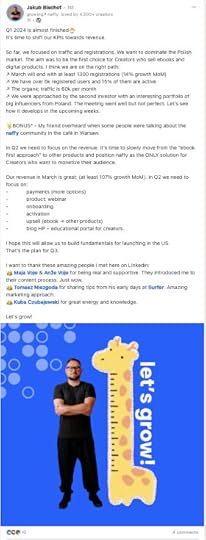
How can we best help Jakub set up a sensible analytics system to support what is mission-critical for them in Q2?
Do we sit him down for a few hours to think about the true North Star Metrics?
Is it weekly active users, weekly active paid users, or the number of e-books created?
I do not think so.
Jakub would benefit much more from thinking which is One Metric That Matters - OMTM in his business, which is still in a pre-product-market stage at the moment.
North Star Metric will be a brilliant post-product market fit guide, but One Metric That Matters will keep the lights on before you get there.

OMTM is very compliant with our mission-critical mindset, isn’t it?
As a go-to-market leader, ensure your team understands and agrees with it. I like to believe that if I woke up each and every one of my team members at 3 a.m. and asked them what is mission-critical, I would get the same answer. Your job in communicating this goal is not done before you have perfect awareness and buy-in from the team.
Work backwards from your OMTMThe way we do analytics and reporting in our business right now is very chaotic and wasteful in terms of time and resources. We literally still use a Google sheet to bring all the data together, which gives a poor overview for decision-making since it is a post-mortem, not in real time. Could we do better now? Sure. However, after discovering that I did not want to run Amazon as a prime sales channel anymore, I decided not to build an intermediate solution but wait for the “real deal”.
This is why, with a new launch, it became mission-critical to build a sales analytics system to support our decision-making. More so, we are scaling with ads. Praying that organic LinkedIn reach would support our business forever is a leap of faith assumption that I do not want to risk.
Since we are not at a volume to justify the investment of building any “self-hosted data warehouse”, I went with a tool “from the shelf”. Amplitude was a logical choice since I would also have to monitor product usage, not only acquisition. We also operate in Europe, where data privacy is the #1 bogeyman 👻 for all things digital. I am excited to bring in more user attributes for data segmentation compared to basic Google Analytics settings.
My OMTM for this launch is to get at least 500 new product purchases.
Now I have to work backward:
Project the traffic and CTRs needed to determine the campaign budget and Customer Acquisition Cost (CAC)
Project and measure conversion rates at each stage of the new product
Measure product activation and usage
Project LTV and Churn
And much more…
Here is how I drafted my dashboards - final tweaks pending:

I am excited to drop our analytics Google sheet forever and finally know real-time sales and product usage data.
March 21, 2024
Is your business a “money-making machine”?
This Substack is kindly supported by Amplitude.
The sooner you set up your analytics system in your go-to-market journey, the better you will understand your high-leverage opportunities:
Which features drive the most usage?
Which channels are the highest LTV customers coming from?
Where does your funnel leak?
Avoid these mistakes when setting up your digital analytics: Read here
Dear GTM Strategist,
Last week, I trained a group of companies to pitch to investors and VCs.
One of the most popular slides was “The Money-Making Machine”. 🎰
Most investors want you to prove that if you put X in your money-making machine, 5X, 10X, or more will come out in a certain time.
This is also important if you are bootstrapping. It gives you peace of mind when planning to grow the team, invest in new products, or simply go on vacation without worrying if the business will survive without you.
But the reality for most go-to-market companies is that our money-making machine still needs fine-tuning.
This is how my “money-making machine” looks like an ATM:

What did I miss?
The GTM Strategist book, of course: https://gtmstrategist.com/
Currently, my book is the only product-led part of my business, but not for very much longer. 🤠
Regarding resource allocation, I spend 90% of my time and investments doing marketing and demand generation, but the lion's share (70%+) of the revenue comes from my sales and business development activities.
Many entrepreneurs, advisors, and consultants would start optimizing the “Money making machine” at the top. They would say things like:
“Do more content.”
“Test another channel.”
“Let’s bring more traffic with ads.”
“Let’s create a content generation engine.”
I think differently.
Most often, we start by optimizing the Opportunities and Deal stages.
The logic: If we cannot confidently sell to the leads that we have in the pipeline, why on earth would we bring more leads into a broken sales pipeline?
Never underestimate sales-ledIf I had a magic wand and could only choose one thing in business, I’d be incredible in:
I would choose sales.
No matter what happens- if you can sell, the business will survive and thrive if you sell a really good product.
Often, my mentees (mainly technical founders) cheer for product-led products.
How could they not—it sounds AMAZING that the product would just “sell itself.” Sadly, that rarely happens.
Most businesses bootstrap at the beginning of the go-to-market stage.
In other words, THEY NEED MONEY to re-invest in the product.
This is why we often sell productized services or co-create the product with a client (pilots) to gain valuable funding and insights that will later fuel our transition to product-led growth, which is a part of our original vision.
Of course, there is a natural order of things.
Some products require different approaches.
In plain terms, if you are selling a no-brainer product for $50, sales would be too expensive. It can be an impulse purchase.
On the other hand, if you are selling something more expensive and complex to understand, your prospect will probably want to talk to someone.
The best rule of thumb:
“If something is more expensive than a used car, sales are inevitable.”

Marketing-led, product-led, or sales-led businesses can happily co-exist. There can be more than one.
Here is how I applied this to my business.

Even best-in-class product-led companies such as Ampitude, Figma, Miro, and Zoom have sales teams to help monetize and serve larger accounts.
Getting (more) serious about salesI had a sales challenge in my business.
I spent way too much time preparing offers and I was always late with them.
It took me way too long to embrace the fact that not every offer needs to be an a la carte masterpiece.
The only way how I could start scaling my consulting business was to work on productized services and have standard packages instead of treating each deal like special ops.
I mean, I enjoy solving business problems a lot, but a standardized sales deck became a necessity at this point so that I can react to opportunities quickly and efficiently.
I asked my colleague Matúš Kučera, Head of Delivery and Partner at SALESDOCk, to help me get “my house in order”. With his help, we optimized the offers and calculated the profitability of each deal I was making. The results were very, very useful - overall, I had too many one-of services in my portfolio, there was a very profitable offer that I have not been actively presenting, and there were some offers that were very work-intense and complex to execute as a service. Therefore they were underpriced.
I was so impressed with his work that I invited him to record a podcast episode and work together on the hero image for this substack.
Ta-da! 🎉

Listen to the latest episode of the GTM Strategist with Matuš Kučera here:
I hope I managed to get you more excited about sales today.
It really, really matters and can make a massive difference in your traction.
Happy selling!
Maja



